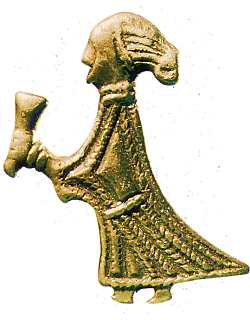
( Or is that Eneleða Falconbro? ) Photo by Jenn R Miller.
I have two Norse dresses, loosely based on the Birka finds, plus some research across a lot of different sources. My smokkr are in a slubby linen-looking stuff and a soft green woven wool blend of plausible design.
So they have the two straps, they’re cut more or less properly, they’re unadorned save the handmade trim on one made by Lady Ysemay Sterling, and there’s the all-important “viking bling.” I made the brooches myself, hand-shaping them with a hammer in an armor dishing stump. (They I modernly sanded on a belt sander them so as not to get covered in burrs and such.) The bling includes some tokens and two strands of beads, one of which was made by my friend Baroness Astrid Ufkilsdottir. My mother added to my research and so their shoulder loops are made nicely and…so on.
It isn’t a perfect kit, but a nice enough one – but there is always the issue of …HAIR.
I sometimes wear “fantasy viking” hair – my hair loose with a few braids. Or just two braids. Or two small braids hanging loose and the rest braided in. But they’re not based on any research.
So this time, I decided to actually *do* my hair.
I’ve seen a lot of small bronze castings of women, and they seem to have a similar hair style – either thickly pulled back and knotted (for long hair) or perhaps braided and then knotted.
Like this:

Or these:

But then….there was THIS ONE.


I could try this hair.
Because I was doing this myself and couldn’t get a lot of good angle on the sides of my head, I braided my hair into only five braids in the front – one on the crest of my brow, and then the other four to my ears. I pulled them back and then gathered them. I tried to knot them but it didn’t work, but loosely looping them up, I secured them with a single large hair pin (I should make some of these in metal – they’re simple but really effective, even in plastic.)
It isn’t as “poofy” in the back, nor as low, but it kind of has the same effect. I’ll continue working on achieving this style I think.
Next time I will use smaller but more numerous braids and try to think how to make them stand out more. I think it will have to do with the length of the top braids, but this will require more work and probably a friend to help.
I’ll keep you posted after the next hairdo!
Note: The more I look at this, the more like dreadlocks it resembles, which would make it stand out that way much better. I’m not going to try that, but you’re welcome to. (If you do, let me know how it goes.)




